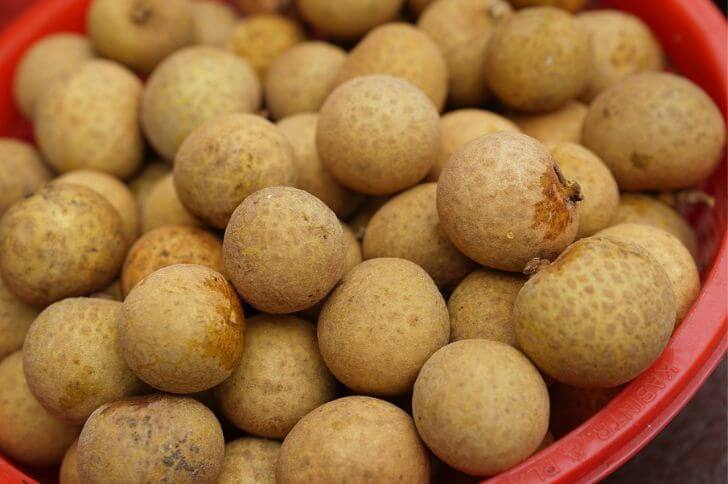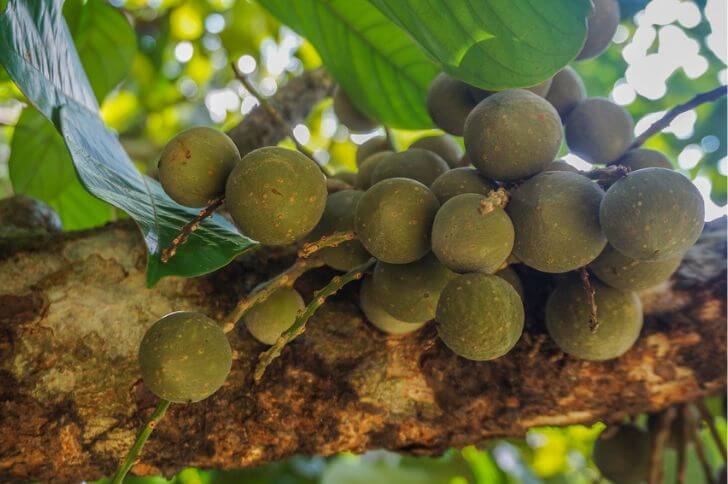Lanzones, also known as duku, langsat, longkong or Lansium parasiticum, is a small, brown fruit native to Southeast Asia. It belongs to the Meliaceae family and has been cultivated for centuries for its sweet and tangy flavor.
The small, round fruits are typically eaten fresh or used in desserts, jams, and jellies.
Its tree can grow up to 98ft (30m) tall and produces clusters of fruits. In this article, we will delve deeper into interesting facts about langsat and its uses.
Where do lanzones come from?
The main countries where lanzones grow are Malaysia, Indonesia, Thailand, and the Philippines. In these countries, langsat is commonly found in local markets and roadside stalls throughout the year.
Even though other regions have tried growing this fruit with little success due to its sensitivity to frost and low temperatures; certain parts of South America and Africa have recently started cultivating this exotic fruit.
Lanzones cultivation

The optimal elevation for growing lanzones trees is between 650-750 meters above sea level. This is because at this height, the temperature ranges from 20-35°C which is suitable for growth.
Lanzones trees are usually propagated by seeds or grafting onto rootstock. They require regular watering and fertilization throughout the year to ensure healthy growth and maximum yield.
Pruning is also necessary to remove dead branches, encourage new growth, and maintain proper tree structure.
Langsat color
The lanzones fruit is a tropical fruit that belongs to the same family as lychees and longans. It is also known by its scientific name, Lansium parasiticum.
The color varies depending on their maturity level. The fruit starts off green when it’s still growing, then turns yellow when it’s ripe.
Aside from yellow, other colors are present in lanzones fruits. When the fruit is starting to mature and develop, its skin takes on a brownish hue that may be mistaken for an unripe fruit.
As it ripens further, the color changes into a yellow-green shade before turning completely yellow at full maturity.
How to tell if lanzones fruit is ripe
One way to tell if lanzones fruit is ripe is by its color. When the outer skin turns from green to yellow or brown, it indicates that the fruit is mature and ready to eat.
Another way to check for ripeness is by pressing gently on the skin with your thumb to check if it gives under pressure.
It’s also important to note that lanzones fruits do not all ripen at the same time on a single tree. Therefore, you may need to check each fruit individually before deciding which ones are ripe and ready for consumption.
Preparation:
To prepare duku fruit, first make an incision in the skin with a knife or your fingernail. Be careful not to cut too deep as this can damage the flesh inside.
Next, use your fingers to peel away the skin and reveal the white translucent flesh inside.
You may encounter some sticky sap during this process but don’t worry – it’s harmless and can easily be washed off with water.
Once you’ve removed all of the skin, simply pop the lanzones fruit into your mouth and enjoy its sweet and tangy flavor.
Related Read: Learn about the Arrayan fruit
Nutrition value
Lanzones fruit is low in calories and contains essential nutrients like vitamins C and B complex, potassium, calcium, iron, magnesium and phosphorus.
One serving of lanzones fruit contains approximately 57 calories. It also provides about 0.8 grams of protein, 9.8 gm of carbohydrates and less than half a gram of fat.
When is lanzones fruit in season

Duku trees take about 20-25 years to mature and produce flowers during the rainy season, which then develop into fruits after one to four months of pollination.
Typically, lanzones fruits are in season from June to October in Southeast Asian countries such as Vietnam, Malaysia, Thailand, Indonesia, and the Philippines.
It’s important to note that once harvested, lanzones fruits have a short shelf life and should be consumed within three to five days. So if you’re lucky enough to come across some fresh dukus during their season, don’t hesitate to try them out!
What do lanzones taste like?
The fruit is similar to its cousin, the lychee, with a hard outer shell that must be peeled to reveal the soft and juicy flesh inside. Lanzones fruit tastes sweet and slightly tangy.
Some people compare the taste to pomelos while others say lanzones taste like grapes.
The texture of lanzones fruit is also similar to lychee, with a soft and fleshy interior that surrounds a large seed in the center.
Some people describe the texture as being somewhat grainy or mealy, while others find it to be smooth and creamy. Overall, lanzones fruit can be quite refreshing on a hot day due to its sweet and juicy flavor.
Another unique aspect of lanzones fruit is its aroma. When ripe, the skin of the fruit emits an intense fragrance that has been described as floral or even musky. This aroma can be quite strong and may take some getting used to for those who are unfamiliar with it.
Eating langsats
1. Eat it fresh: The most common and simple way to eat lanzones fruit is by peeling off the skin and eating it fresh.
Once peeled, you’ll see the white flesh that surrounds a large seed in the center. You can either bite into it or just suck on the flesh to extract its sweet juice.
2. Make a salad: lanzones fruit can be an excellent ingredient for salads due to its juicy texture and sweet flavor. You can chop up some lanzones fruit and add it to your favorite salad recipe for an extra dose of sweetness.
3. Bake into desserts: lanzones fruit pairs well with desserts like cakes, pies, and tarts. You can puree lanzones fruit and use it as a filling in these desserts or simply slice them thinly on top as a garnish.
Langsat drinks
You can enjoy lanzones fruit by juicing it. Simply remove the seeds and blend the flesh with water, then strain. Sweeten with honey if desired.
Another way to drink lanzones fruit is by turning it into a smoothie. Blend with bananas, strawberries, or mangoes, add yogurt for a creamy texture. This refreshing drink makes an excellent breakfast option or post-workout snack.
Lastly, you can also use lanzones fruit to make cocktails and mocktails. Muddle the flesh with mint leaves and lime juice, then add rum or soda water for a refreshing summer drink.
For non-alcoholic options, replace rum with coconut water or lemonade for a fruity twist on traditional drinks.
How to store lanzones
To store lanzones fruit, it is best to keep them at room temperature for up to 3 days. If you want to extend their shelf life, you can store them in the refrigerator for about a week. Before refrigerating the fruit, make sure they are dry and free from any bruises or cuts.
If you plan on storing lanzones fruit for longer periods, you can freeze them. Start by removing the flesh from the seed and packing it into an airtight container or freezer bag.
Where can you get lanzones fruit
If you are in Southeast Asia, particularly in Vietnam, Malaysia or Thailand, lanzones fruit can be easily found in local markets or grocery stores during its peak season which falls between June to October.
In Indonesia, especially on the island of Sumatra and Java, it is called langsat and can also be found easily within this period.
However, if you are not living in any of these areas but still want to try this exotic fruit for yourself, there may be some specialty markets or online stores that import them from their origin countries.
Langsat vs longan
Langsat and longan are two popular tropical fruits that look quite similar, but they have different origins and tastes.
Langsat is native to Southeast Asia, while longan originated in China. Both fruits belong to the same family as lychee and rambutan.
The langsat fruit has a thin, yellowish skin that is easy to peel. The flesh inside is translucent and juicy with a sweet-sour taste. It contains small seeds that are easily removed from the flesh.
On the other hand, longan fruit has a brownish skin with tiny bumps all over it. The white, juicy pulp inside has a mild sweetness and musky flavor. It has one black seed.
sources:
Hi There,
My name is Jenny. I’m the Chief Editor at Try Green Recipes and besides making yummy and healthy foods for my kids, grandkids, and friends. I’m new to the blogging world but I believe what I have to share is unique and will bring joy to your home. If you are adventurous and want try something tasty, let’s get started.

